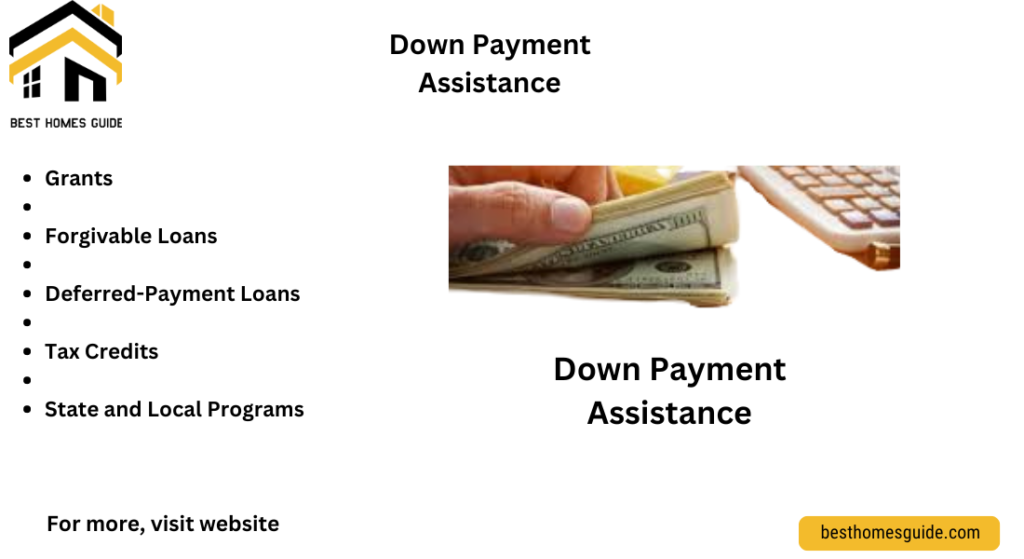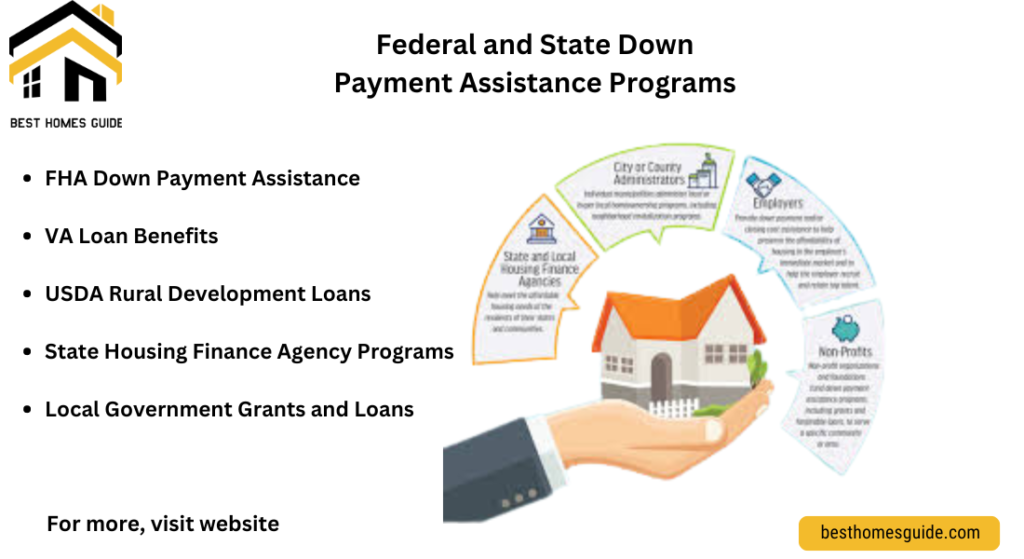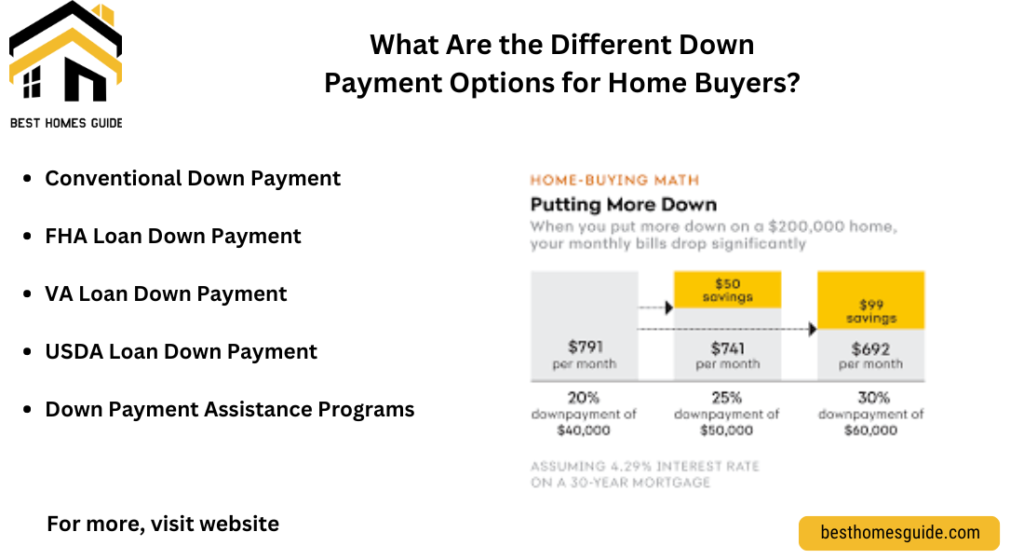When buying a home, one of the biggest hurdles can be the Down Payment Options for Home Buyers down payment options and assistance programs available to help home buyers, especially first-time buyers, achieve their dream of homeownership. Down payment assistance programs, their eligibility criteria, and how they work to make the home buying process more accessible and affordable. Whether you’re considering a grant, a forgivable loan, or other forms of assistance, understanding your options can significantly impact your financial planning and decision-making.
What Are Down Payment Assistance Programs?
Down Payment Options assistance programs are designed to help potential home buyers cover the initial costs of purchasing a home. These programs can come in the form of grants, loans, or matched savings and are typically offered by government agencies, non-profits, and even some private lenders. They aim to reduce the financial burden of the down payment, making homeownership more attainable for those who may not have significant savings.
Types of Down Payment Assistance:
- Grants: Funds that do not require repayment, often considered a gift.
- Forgivable Loans: Second mortgage loans that may be forgiven if certain conditions are met.
- Deferred-Payment Loans: Loans where repayment is deferred until you sell or refinance the home.
- Low-Interest Loans: Affordable second mortgages with lower interest rates to complement your primary loan.
- Matched Savings Programs: Programs where your savings are matched by an organization to help increase your down payment fund.
Eligibility for Down Payment Assistance Programs: Eligibility for these programs often depends on various factors including income, credit score, and whether you are a first-time home buyer. Some programs have specific requirements such as completing a home buyer education course or purchasing a home in a designated area.
Down payment assistance programs and understanding their requirements, home buyers can find the support they need to make their homeownership dreams a reality.
Who Qualifies for Down Payment Assistance?
Down Payment Options assistance programs are typically aimed at helping first-time home buyers or those who have not owned a home in the past three years. To qualify, applicants must meet specific eligibility criteria, which can vary by program but generally include income limits, credit score requirements, and other financial assessments.
Income and Credit Requirements: Most down payment assistance programs set income limits based on the area’s median income to ensure they target low- to moderate-income buyers. For example, the income used to qualify for these programs often cannot exceed 80% of the median income in the area where you are looking to buy a home. Many programs require a minimum credit score, which can range from 620 to 640 or higher, depending on the specific assistance program and the type of loan you are applying for
Other Eligibility Criteria: Applicants are typically required to use the property as their primary residence, meaning investment properties are generally not eligible. There are often requirements regarding debt-to-income ratios and homebuyer education courses. For instance, some programs mandate the completion of a homebuyer education class to ensure buyers are well-prepared for homeownership responsibilities.

Types of Down Payment Assistance Programs
Down payment assistance programs come in various forms, each designed to help buyers cover their upfront costs in different ways. Here are the most common types:
Grants: Grants are one of the most valuable forms of down payment assistance because they do not need to be repaid. These are often provided by government agencies or non-profit organizations and can significantly reduce the financial burden on home buyers
Forgivable Loans: Forgivable loans are essentially second mortgages that do not require repayment as long as the borrower meets certain conditions, such as living in the home for a specified number of years. These loans often have a 0% interest rate and are forgiven over a period, typically ranging from five to 20 years
Deferred-Payment Loans: These loans allow buyers to defer repayment until they sell, refinance, or pay off their first mortgage. While these loans also often come with a 0% interest rate, they must be repaid eventually, unlike grants or forgivable loans.
Low-Interest Loans: Some programs offer low-interest loans that can be used to cover the down payment. These loans are paid back in regular installments, which adds to the monthly mortgage payment but can make homeownership more accessible by lowering the initial financial barrier
Matched Savings Programs: Matched savings programs, also known as individual development accounts, involve a third party matching the buyer’s savings to help them reach the Down Payment Options amount. These programs encourage savings by doubling the funds set aside by the buyer for the down payment.
How to Apply for Down Payment Assistance?
Applying for down payment assistance involves several steps, starting with researching the available programs and understanding their specific requirements. Here’s a general process to follow:
Research Programs: Start by exploring the different down payment assistance programs available in your area. This can include checking with state and local housing finance agencies, non-profit organizations, and even your lender. Websites like HUD.gov provide comprehensive lists of available programs.
Determine Eligibility: Once you have a list of potential programs, narrow it down by determining which ones you qualify for based on income, credit score, and other criteria. Each program will have its own set of eligibility requirements, so it’s important to review these carefully
Complete Required Education: Many programs require applicants to complete a homebuyer education course. These courses cover essential topics like budgeting, mortgage processes, and maintaining your home, ensuring you are well-prepared for homeownership.
Submit Application: Gather the necessary documentation and submit your application. This typically includes proof of income, credit reports, and other financial information. Be prepared to attend meetings or counseling sessions as part of the application process By following these steps and leveraging available resources, home buyers can find and secure the down payment assistance they need to make their homeownership dreams a reality.
Federal and State Down Payment Assistance Programs
Federal and state down payment assistance programs provide essential support for home buyers, particularly those purchasing a home for the first time. These programs can significantly reduce the financial burden of the initial costs associated with buying a home.
Federal Programs: The Federal Housing Administration (FHA) offers loans that require a lower down payment and can be combined with down payment assistance programs. For example, FHA loans allow buyers with credit scores of 580 or higher to make a down payment as low as 3.5% of the home’s purchase price. The U.S. The Department of Veterans Affairs (VA) provides zero-down loans to qualifying veterans, service members, and some dependents, eliminating the need for a down payment entirely. the USDA offers loans for rural home buyers that may require no down payment, focusing on supporting low- and moderate-income households in rural areas.
State Programs: Each state has its own Down Payment Options assistance programs, often administered by state housing finance agencies. For instance, the Alabama Housing Finance Authority (AHFA) offers programs like the Step Up DPA, which provides up to 4% of the purchase price as a down payment on a new or existing home. This assistance comes as a 10-year second mortgage, provided the applicant meets specific income and credit requirements (The Mortgage Reports). Alaska offers the Affordable Housing Enhancement Loan Program (AHELP), which includes grants, forgivable loans, and deferred-payment loans to assist with down payments. Similar programs exist across other states, each with unique eligibility criteria and benefits.

Using Gift Funds for Down Payments
Gift funds can be a valuable resource for covering your down payment. Many loan programs, including conventional and FHA loans, allow home buyers to use gift funds from family members, friends, or employers.
Rules and Documentation: To use gift funds, you must provide proper documentation to your lender. This typically includes a gift letter from the donor stating that the money is a gift and not a loan that needs to be repaid. The letter should detail the amount of the gift, the donor’s relationship to the buyer, and the source of the funds. Proper documentation ensures transparency and helps prevent any issues with the loan approval process.
Eligible Donors: Gift funds can come from various sources, including parents, other relatives, friends, or even employers. Some programs, like the Conventional 97 loan and Freddie Mac Home Possible, allow 100% of the down payment to be covered by gift funds . It’s essential to inform your lender early in the process if you plan to use gift funds to ensure all necessary steps are followed correctly.
Advantages and Disadvantages of Small vs. Large Down Payments
The size of your down payment can significantly impact your mortgage terms and overall financial situation. Both small and large down payments have their pros and cons.
Benefits of a Smaller Down Payment: Making a smaller down payment allows you to preserve more of your savings for other expenses, such as emergency funds or home improvements. It also enables you to enter the housing market sooner, which can be advantageous if home prices are rising.Many down payment assistance programs are specifically designed to help buyers making smaller down payments, potentially offering grants or low-interest loans to cover the upfront costs .
Advantages of a Larger Down Payment: A larger down payment reduces the loan amount, leading to lower monthly mortgage payments and less interest paid over the life of the loan. It may also help you secure a lower interest rate and avoid the need for private mortgage insurance (PMI) if you put down 20% or more on a conventional loan. In competitive real estate markets, a larger down payment can make your offer more attractive to sellers.
The right Down Payment Options amount depends on your financial situation, goals, and the specific loan programs you qualify for. Consulting with a financial advisor or loan officer can help you determine the best strategy for your circumstances.
Tips for First-Time Home Buyers
When planning to buy a home, especially for the first time, it’s essential to prepare both financially and logistically. Here are some key tips to help you navigate the process smoothly:
Understand Your Budget: Before you start house hunting, it’s crucial to understand what you can afford. Use tools mortgage calculators to estimate your monthly payments, considering different down payment amounts and interest rates. This will give you a clear picture of your budget and help you avoid overextending your finances. Factor in other costs, closing fees, property taxes, and home maintenance to ensure you have a comprehensive understanding of your financial commitment.
Get Pre-Approved for a Mortgage: Securing a mortgage pre-approval can give you a significant advantage in the home buying process. It not only shows sellers that you are a serious buyer but also helps you understand how much you can borrow based on your financial situation. This step involves a lender reviewing your credit, income, and assets to determine your loan eligibility and amount
Save for Additional Expenses: Beyond the down payment, first-time home buyers should be prepared for other expenses such as closing costs, moving expenses, and home repairs. Closing costs can range from 2% to 5% of the home’s purchase price and include fees for the appraisal, inspection, and loan processing. Setting aside funds for unexpected repairs and maintenance will help you manage your new home comfortably without financial stress
What Are the Best Down Payment Options and Assistance Programs for Home Buyers?
Navigating the various down payment options for home buyers can be complex, but understanding the available programs and strategies can significantly ease the process. Federal and state programs offer numerous forms of assistance, including grants, forgivable loans, and deferred-payment loans, all designed to make homeownership more accessible. Utilizing gift funds can also be a valuable resource, provided they are properly documented and used in compliance with lender requirements.
When considering the size of your down payment, it’s crucial to weigh the pros and cons. Smaller down payments can help you enter the market sooner and preserve your savings for other expenses. Larger down payments reduce your loan amount, lower your monthly payments, and potentially eliminate the need for private mortgage insurance. Each option has its benefits and drawbacks, and the best choice depends on your individual financial situation and long-term goals.
For first-time home buyers, thorough preparation is key. Understanding your budget, getting pre-approved for a mortgage, and saving for additional expenses are essential steps that can help ensure a smooth and successful home buying experience. By taking advantage of the available resources and planning carefully, you can make informed decisions that align with your financial goals and secure your path to homeownership.
What Are the Different Down Payment Options for Home Buyers?
- Conventional Down Payment: Typically 20% of the homes purchase price, avoids private mortgage insurance (PMI) but requires substantial savings.
- Federal Programs: Includes FHA loans with low down payment requirements (as low as 3.5%) and VA loans that may require no down payment for eligible veterans.
- State and Local Programs: Offer grants, forgivable loans, or deferred-payment loans to assist with down payments, often targeted at first-time buyers.
- Gift Funds: Funds from family or friends can be used for a down payment if properly documented and compliant with lender requirements.
- Employer Assistance: Some employers offer homebuyer assistance programs or down payment assistance as part of employee benefits.

How Do Federal and State Programs Assist with Down Payments?
Grants: Provide funds that do not need to be repaid, often based on income and homebuyer qualifications.
Forgivable Loans: Loans that are forgiven after a certain period or if specific conditions are met, reducing repayment obligations.
Deferred-Payment Loans: Loans with payments postponed until the home is sold or refinanced, making it easier to manage initial costs.
Down Payment Assistance Programs: Offered by state and local governments, these programs help cover part of the down payment or closing costs.
Tax Credits: Some programs offer tax credits that reduce the total cost of purchasing a home, making homeownership more affordable.
Can Gift Funds Be Used for a Down Payment and What Are the Requirements?
Yes, Gift Funds Can Be Used: They are commonly accepted for Down Payment Options, especially in conventional and FHA loans.
Documentation Required: You must provide a gift letter from the donor stating the funds are a gift and not a loan.
Proof of Transfer: Lenders typically require evidence of the transfer of funds, such as bank statements or wire transfer records.
Compliance with Lender Guidelines: The gift must comply with the lender’s specific requirements and be documented properly.
No Repayment: The funds must not be expected to be repaid, as they are considered a gift, Down Payment Options not a loan.
What Are the Pros and Cons of Making a Smaller vs. Larger Down Payment?
Smaller Down Payment
Pros:
- Lower Upfront Cost: Easier to save and enter the market sooner.
- Preserves Savings: Allows you to keep more cash for other expenses or investments.
Cons:
- Higher Monthly Payments: A larger loan amount means higher monthly mortgage payments.
- Private Mortgage Insurance (PMI): Often required if the down payment is less than 20%, adding to monthly costs.
Larger Down Payment
Pros:
- Lower Monthly Payments: Reduces the loan amount and monthly mortgage payments.
- Avoids PMI: A Down Payment Options of 20% or more often eliminates the need for PMI.
- Lower Interest Rates: May qualify for better mortgage rates.
Cons:
- Higher Upfront Cost: Requires a larger sum of money saved, which can delay your home purchase.
- Less Cash Reserves: Reduces available savings for other expenses or emergencies.
How Can First-Time Home Buyers Prepare Financially for a Down Payment?
Create a Budget: Outline your income and expenses to determine how much you can save each month.
Save Regularly: Set up a dedicated savings account and automate transfers to build your down payment fund.
Explore Assistance Programs: Research and apply for federal, state, or local down payment assistance programs.
Reduce Debt: Pay down existing debts to improve your credit score and increase savings potential.
Get Pre-Approved: Obtain a mortgage pre-approval to understand your borrowing capacity and refine your savings goals.
